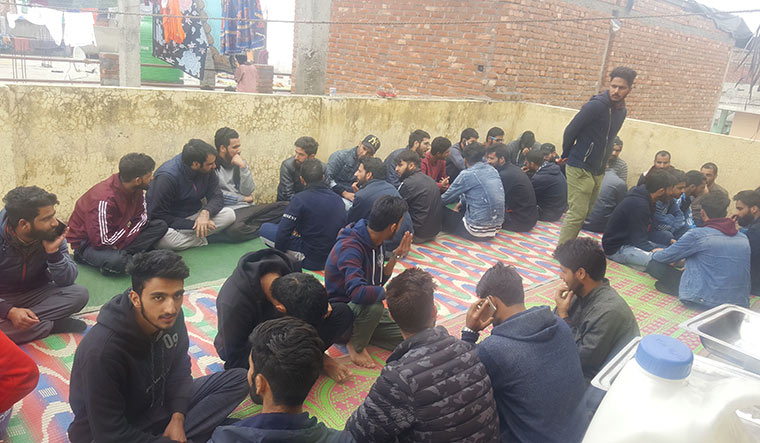VISHWA HINDU DAL activists Bajrang Sonkar, Amar Mishra and Ambuj Nigam have been accused of attacking two Kashmiri traders in Lucknow on March 6. Sonkar, the main accused, is a history-sheeter. The Lucknow police arrested them after a video of them thrashing traders Afzal Nayak and Abdul Salam Nayak went viral and evoked widespread condemnation.
In the video, Sonkar and Mishra, wearing saffron kurtas, were seen hurling abuses at the Kashmiris and hitting one of them with a stick. But, what happened in Lucknow was not a standalone incident. It was one among many attacks on Kashmiris by right-wing mobs after the Pulwama terror strike on Valentine’s Day.
On February 22, the Supreme Court directed ten states to take “prompt action” to prevent social boycott of Kashmiris. But, many believe that the attacks have intensified the feeling of alienation and victimhood among the Kashmiri youth.
On March 9, while addressing a rally in Kanpur, Prime Minister Narendra Modi described Dal members as “crazed people” and urged state governments to take strict action against people who target “our Kashmiri brothers”.
Apparently, Modi’s statement came only after National Conference vice president Omar Abdullah criticised him for his silence. In an earlier incident, on February 18, a Kashmiri shawl seller, Javed Ahmed Khan, was beaten by a mob in Nadia, West Bengal, and was forced to chant Bharat Mata ki jai. A video clip of the incident, showing Khan with a bleeding nose evoked widespread condemnation. A day later, West Bengal Chief Minister Mamata Banerjee told the media that those attacking Kashmiris in West Bengal would not be spared. According to an informed source, Khan has decided not to register a case against those who attacked him and continues to do business in Kolkata, where he has been working for the past decade.
But, what triggered an alarm and anger in Kashmir were the attacks on Kashmiri students in Uttarakhand and Haryana. A few Kashmiri students in these states were either suspended or expelled from their colleges for writing “offensive posts” on social media. Salman Shaheen, a Kashmiri from Baramulla who taught English at Lovely Professional University in Punjab, was also sacked for his Facebook comments. THE WEEK contacted Shaheen, but he refused to talk. A local daily in Srinagar quoted him as saying that his comments were morphed.
Nasir Khuhami of Kashmir Students Organisation (KSO), a union of Kashmiri students studying outside the state, said that the organisation had set up a helpline via WhatsApp after the Pulwama attack. “Several Kashmiri students were thrashed at different places by members of the Bajrang Dal and Vishva Hindu Parishad,” he said. “We have never faced such discrimination or inconvenience before.”
What caused panic among Kashmiri students in Dehradun, the capital of Uttarakhand, was the 12-hour ultimatum given by right-wing activists to leave the city. Khuhami said that the mobs raided hostels where Kashmiri students were staying.
The mob also pressured the management of Alpine Institute of Management and Technology, Dehradun, to expel its dean, Adil Kuchay, who is from south Kashmir. “[However], the management did not terminate my service. They issued a letter without any order and reference,” Kuchay told THE WEEK. “The college took great care to ensure that the students left Dehradun safely, in their own buses and with escort.” He added that the Dehradun police and social activists like Rashid Pahalwan, who hosted 300 Kashmiri students for several days, handled the situation well.
A girl from Alpine Institute was suspended for a Facebook post. Kuchey said that she had put up the stickers of a former student of the college who had joined a militant outfit and got killed. “I asked her to focus on her studies,” he said.
An estimated one lakh students from Kashmir are enrolled in different educational institutions across India, including beneficiaries of the Prime Minister’s Special Scholarship Scheme (PMSSS). Most of the students, who returned to Kashmir after attacks, are keen to return to their colleges.
The PMSSS was launched by UPA-II in 2010, after a major conflict period in the valley in which 110 civilians were killed and hundreds were injured. Under the PMSSS, the Union government pays a student Rs95,000 towards college fees and Rs50,000 towards other expenses every year. The scheme aims to remove the sense of alienation among Kashmiri youth and help integrate them into the mainstream. Many students, especially those from the economically weaker section, have benefited from the scheme.
At least five of the institutions where Kashmiri students were targeted are covered under the PMSSS. These include Geeta Engineering College in Panipat, Moradabad Institute of Technology (MIT), Quantum University in Roorkee, Bharat Institute of Technology in Meerut, and Shree Guru Gobind Singh Tricentenary University in Gurgaon—all of which either suspended or expelled Kashmiri students for their posts on social media. One student suspended from MIT and another suspended from Bharat Institute of Technology were PMSSS beneficiaries. Some of the colleges have also decided not to admit Kashmir students under the PMSSS from the next academic year. There are fears that the violence and retaliatory actions against Kashmiri students could undo the gains brought by programmes like the PMSSS over the years, and could further complicate efforts towards integration.



